2015
Fertilizer Placement With Seed
As farmers are preparing for the upcoming planting season, a common question is “What is the maximum amount of fertilizer that can be in-furrow applied with crop seed?” Two references are available to help answer this question.
- NDSU Extension Service circular EB-62 ‘Fertilizer application with small grain seed at planting’. The publication lists many factors involved with determining small grain seed tolerance to fertilizer placed with the seed. Two tables in the publication show the maximum nitrogen fertilizer rates based on planter spacing, planter type, seedbed utilization and soil texture. For example, the maximum N rate for placement with wheat seed planted with an air seeder with 10-inch row spacing and 4-inch seed spread is 37-48 lb of N/acre. The publication can be found at the website: http://www.extension.umn.edu/agriculture/small-grains/nutrient-management/docs/fertilizer-application-with-small-grain-seed-at-planting.pdf.
- SDSU has an electronic fertilizer seed decision aid. The recommendation on maximum amount of fertilizer applied with seed can be determined by choosing numerous crops and fertilizers, plus seed furrow width, row spacing, tolerated stand loss (%), soil texture and soil moisture at planting. As an example, the maximum rate of 10-34-0 liquid fertilizer for placement with soybean planted in 22-inch rows in medium-textured soil that is moist at planting time is 1.2 gal/acre. The Excel file can be used on your computer or as an app on your mobile device. The website: www.sdstate.edu/ps/extension/soil-fert/fertapp.cfm.
Greg Endres
Area Specialist, Cropping Systems
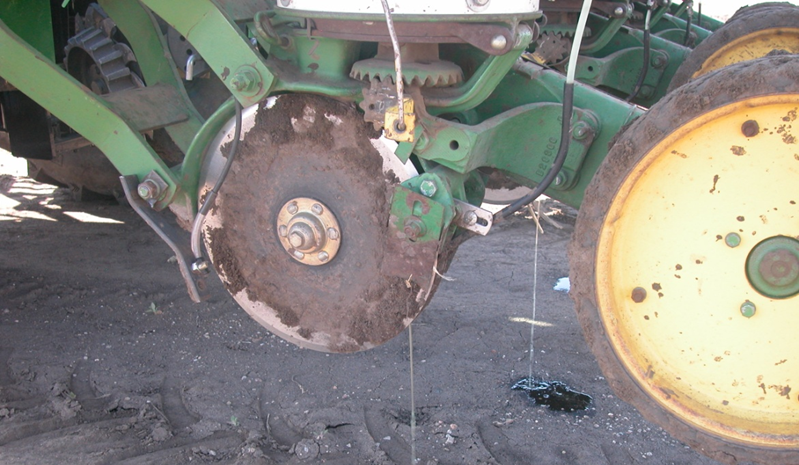
Local Grains
“Local grains” is a specialized view of agriculture that supports value-added, organic, or small-scale production and especially encourages the use of foods grown in close proximity to the point of consumption.
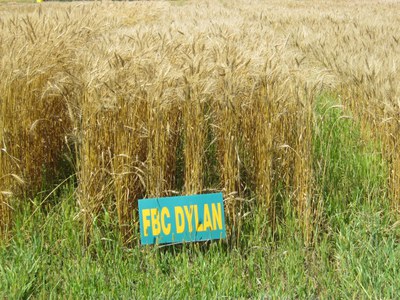 The CREC will be a host site for a Local Grains webinar conference on March 19. The conference begins at 10:30 a.m. and will conclude at 3:00 p.m. Face-to-face, local conversations will begin the meeting followed by the live-streamed conference. Steve Zwinger, agronomy research specialist at the CREC will talk about his work with local processors and specialty grains following the webcast.
The CREC will be a host site for a Local Grains webinar conference on March 19. The conference begins at 10:30 a.m. and will conclude at 3:00 p.m. Face-to-face, local conversations will begin the meeting followed by the live-streamed conference. Steve Zwinger, agronomy research specialist at the CREC will talk about his work with local processors and specialty grains following the webcast.
Individuals quickly become specialized in their specific role with local grains, whether as farmers, millers, maltsters, or bakers, but local grains systems work best when all of the people involved understand each other's needs and constraints. This conference will provide an opportunity to share this collective knowledge with a local and national audience.
Pre-registered participants will be provided with a sack lunch; walk-in participants are encouraged to bring a lunch with them. There is no cost to attend and the conference is open to the public.
To pre-register for this conference, contact the Carrington REC at 701-652-2951 or email steve.zwinger@ndsu.edu or ND SARE (Sustainable Agriculture Research and Education) coordinator Karl Hoppe at karl.hoppe@ndsu.edu.
Steve Zwinger
Agronomy Research Specialist
Applying nitrogen with the planter using ESN (Environmentally Sensitive Nitrogen) and Urea: research update
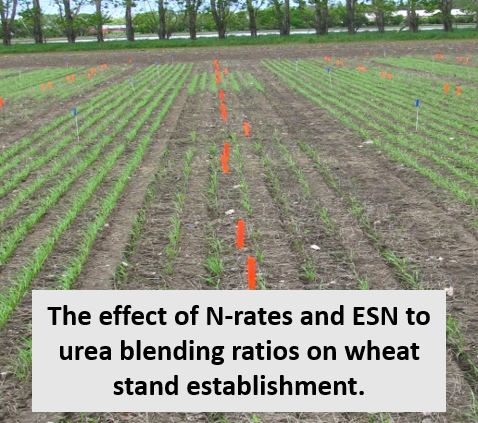
Applying fertilizer down the tube with the seed is a time and cost-saving practice which eliminates the need for additional equipment to apply fertilizer. In the case of urea, it also mitigates losses from volatilization. The challenge with this method is avoiding a substantial reduction in stand due to the damage that urea causes when it comes in close contact with the seed. Yet, there is growing interest in using this method and some farmers have reported positive outcomes with it.
ESN is a slow release nitrogen (N) fertilizer product made of polymer coated urea granules. It has been shown to be a good alternative to uncoated urea when it comes to in-furrow nitrogen application. However, due to the price difference and availability there was interest in looking at blending ESN with urea to see what the lowest ESN to urea ratio might be that can still safely be applied with the seed. For this reason a trial was set up in 2013 and 2014 in Carrington to test the safety and yield effects of ESN blended with urea and applied at different rates at planting.
Excerpts from the results of this study are shown in the graphs.
In this trial, ESN and urea were applied with the seed at different blending ratios and at different N rates. Seed applied fertilizer treatments were compared with broadcast application. Early season stand counts showed that damage to the seed increased with nitrogen rates and with urea to ESN blending ratios in both years. In 2013, the stand was especially harshly affected by seed damage from urea, which caused significant reduction in the yield as well. The plots receiving 100% ESN with the seed did not suffer a great reduction in stand, and the yield was higher than the yield from broadcast application of the same N rate. In 2014, there was no significant difference between the yields and stand counts for the different blending ratios. Stand counts were reduced at higher N rates. In spite of this, grain yield increased with N rates regardless of ESN to urea blending ratio. The 2014 results might suggest that at the 90 lbs/A nitrogen rate, ESN can be blended with urea up to 50% to reduce cost and can still be safely applied with the seed. On the other hand, the 2013 results suggest a more cautious approach. The difference in the outcomes of the two years is possibly due to the length of time that passed between planting and the first major rainfall event. In 2013 it rained 0.27 inches 3 days after planting and 0.13 inches the day after that. In 2014 it rained 0.37 inches within 24 hours of planting and 0.24 inches the day after that. In addition, soil temperature or moisture status may have played a part in minimizing the burning effect of urea on the seeds at these different dates. For example, the NDAWN turf soil temperature for 2014 (45°F) was 20 degrees less than in 2013 (64°F).This study will be continued in 2015 to collect additional data before any conclusions can be drawn.
Summary:
- In 2013, seed contact with plain urea caused significant reduction in yield, but plots receiving 100% ESN had good yield response to N-rates.
- In 2014, grain yield increased with nitrogen rates regardless of ESN to Urea blending ratio.
- Difference between two seasons possibly due to how soon plots received rainfall after planting.
- More data to be collected in 2015.
Szilvia Zilahi-Sebess
Agronomy Research Specialist
The Pieces and Parts of Grapes
It’s March and that means it’s time to think about pruning your woody fruit plants. In general, this is a good month to start pruning in North Dakota. The coldest weather should be over and it shouldn’t be too long before new growth will close over the pruning wounds. You still have some time - you just want to get it done before the buds start to swell. Today, we’ll talk about grapes because they can be such a mystery to everyone.
A perfectly trained and pruned plant will look like the one in the picture. Yours probably won’t be perfect like this, but use it as a general guide for the structure of the plant.
All trained grapes have a vertical trunk and then horizontal cordons. These parts are considered ‘permanent’ though they can be renewed if something happens to them.
The area where you do your major pruning each year is on the spurs. These areas were the original lateral (side) shoots of the original canes you tied onto the trellis wire. Each spring you cut back those old lateral shoots (called canes once they turn woody) so that there are only 2 or 3 live buds left there. In a few years you get this woody, knobby area that we call the spur.
The live buds that will produce this year’s fruit are on last year’s canes and are called ‘count nodes’ or ‘count buds’. These will have smooth, reddish- or tannish-colored bark. Older parts of the plant will have grey and peeling bark.
Only 1-year-old wood has fruit buds. That’s why we cut away all that other growth. Removing old canes invigorates the plant to grow new shoots that turn into next year’s canes. Good grape pruning will remove 85-90% of last year’s wood. Don’t worry – all the energy the grape needs to grow is down in the roots. You will NOT kill the plant by removing all that old stuff! You will make great fruit for yourself and possibly your neighbors.
Look on our website for a more detailed description of pruning.
Here are two excellent pruning videos from Oregon State University:
Kathy Wiederholt
Fruit Project Manager
SARE - Sustainable Agriculture Research and Education
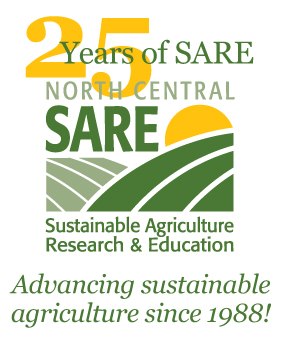
- farmers
- ranchers
- scientists
- educators
- institutions
- youth educators
- organizations
- others exploring sustainable agriculture
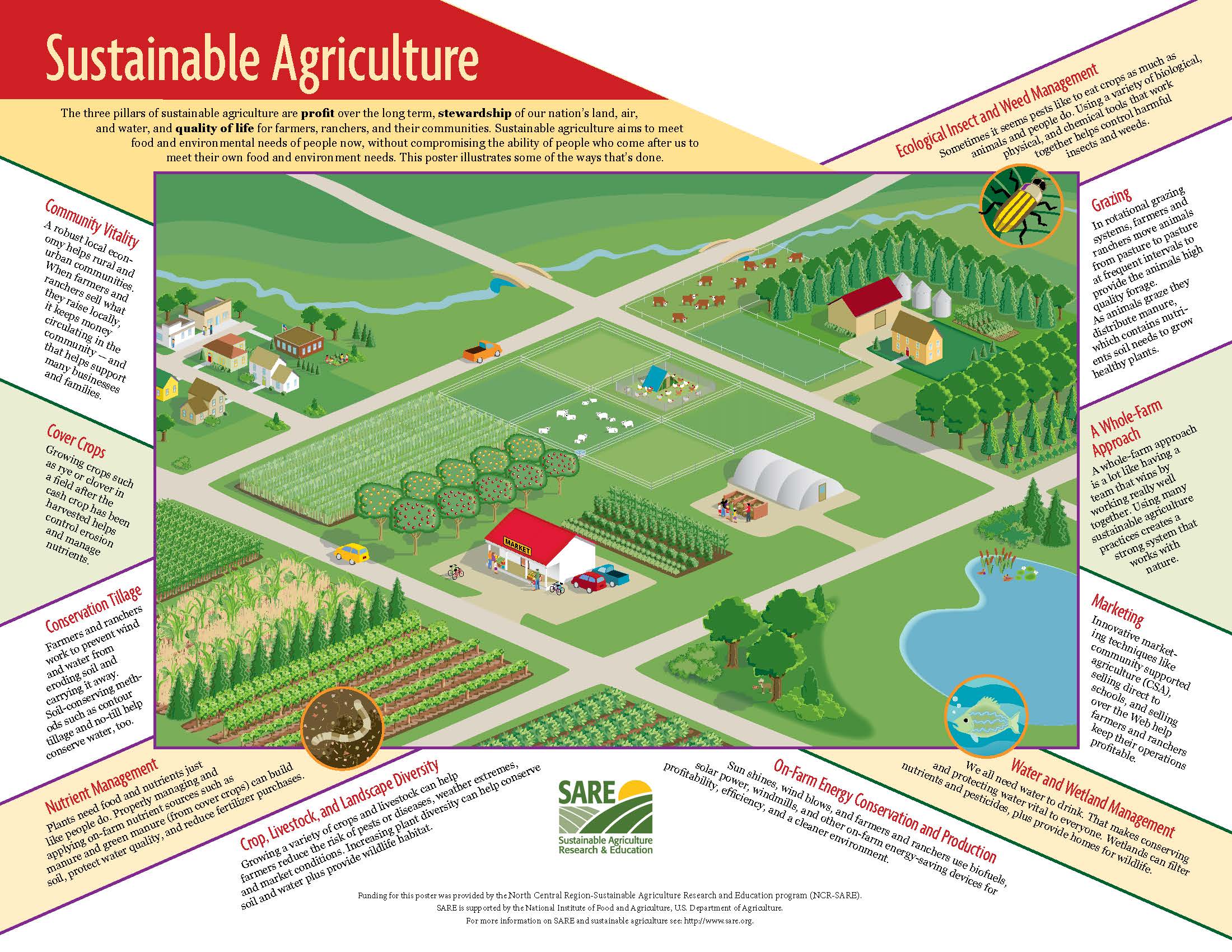
Unmanned Aerial Systems (UAS) Technology at the CREC
In 2014, the Carrington Research Extension Center was named a test site for studying the integration of unmanned aerial vehicles into civilian airspace. As part of this project, our goal was to make flights around some of the research trials we were conducting to see what information we could collect. Another part of that goal was to take ground-based data and compare it to the aerial-collected data. Most of the images this year were taken with a Dragonflyer quadcopter. Figure 1 was captured with a fixed wing Trimble model.
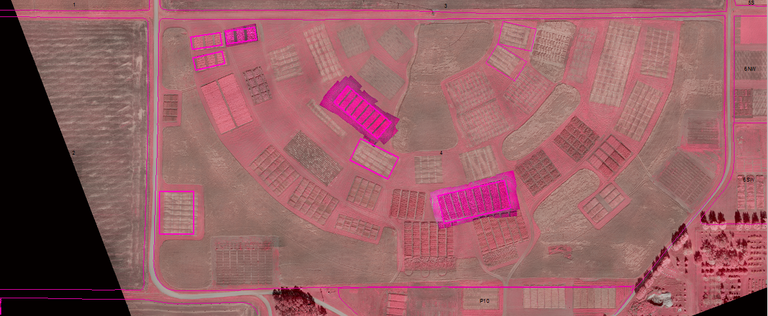
Figure 1. An infrared image of irrigated research plots at the CREC.
We had several types of information we were hoping to collect including crop fertility, weed control, disease severity, crop moisture stress, crop maturity, and cattle body temperature. Here are some examples of the data we have gather so far:
Table 1. Comparison of ground and aerial-based measurements for yellow foxtail control in spring wheat.

Table 1 is a good example of the comparison between a handheld Greenseeker sensor and the aircraft. NDVI is simply an index that is used in remote sensing to compare the relative health or nutrient levels of a plant. The handheld unit did not provide much information about weed control, and neither did an initial scan of the image taken from the aircraft. However, with the unmanned aerial vehicle (UAV) image, a specific area can be targeted. In this case we looked at weed control in-between the wheat rows and found a nice correlation with the visual estimate of weed control.
Figure 2 is an NDVI image of a soybean variety trial at the CREC. The picture was taken in late September at a time when many soybean varieties were quickly losing leaves but some later maturing lines still had full foliage. In the picture, green areas represent varieties with many leaves. The dark red colors represent bare ground. So the more red an area is, the more leaves have dropped off the plants.
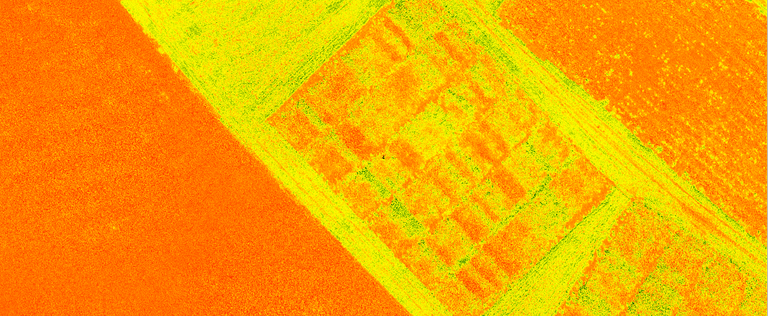
Figure 2. An NDVI image of a soybean variety trial.
In Figure 3, we quantified the data from Figure 2 and found a fairly strong trend in predicting the date in which soybeans reach physiological maturity.
Figure 3. Predicting soybean maturity using NDVI collected from a UAV. The orange bar represents the date that the flight occurred.
As a final teaser, here is a trial comparing different nitrogen products in wheat. Again, we compared Greenseeker data with the UAV collected data. The actual values are different between the ground-based and aerial-based methods. However, the differences between the values is very similar.
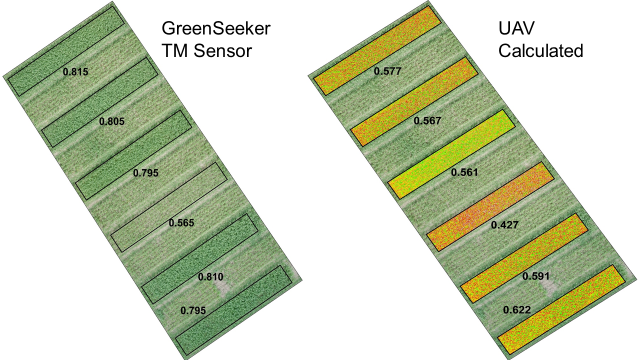
Figure 4. A comparison of nitrogen fertility treatments in wheat using ground and aerial sensors.
This industry is still in its infancy in the United States. There are bound to be great improvements in the speed of processing the data and ease in which it is collected and viewed. While we still have a lot of data to evaluate from this past growing season, we will continue our research efforts in 2015 to see what other information can be gleaned with this new technology. If you would like to learn more or are interested in hearing about our experiences with this technology, feel free to send an e-mail or call the CREC.
Mike Ostlie
Agronomist
Perennial Grasses for Saline Areas
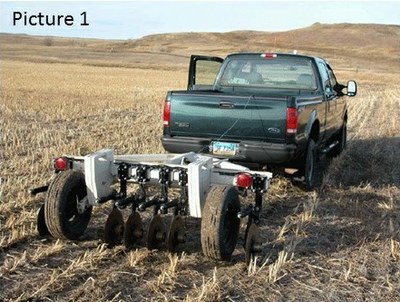 Roughly six million acres in North Dakota are considered saline soils. That’s approximately 13% of the acres in North Dakota or an area about the size of Vermont. The most common way to measure soil salinity is by measuring soil electrical conductivity (EC). For soil to be considered saline, it must have an EC of four or higher. Crops like dry bean, soybean, and corn are affected at EC’s lower than four. Once EC’s get above six most crops are being affected by soil salinity, which affects profitability. Ongoing demonstration plots were established near Carrington and Buchanan in 2010 to determine the most appropriate perennial grass species for various soil salinity levels. Species were selected based on ease of establishment for forage production. A Veris machine (Picture 1) was used to map sites for EC. Sites were ground truthed to determine the field gradient. This information was used to orient plots across the salinity gradient before plots were seeded in 2010. Plots with adequate stands were harvested for hay production and EC readings were taken again after harvest.
Roughly six million acres in North Dakota are considered saline soils. That’s approximately 13% of the acres in North Dakota or an area about the size of Vermont. The most common way to measure soil salinity is by measuring soil electrical conductivity (EC). For soil to be considered saline, it must have an EC of four or higher. Crops like dry bean, soybean, and corn are affected at EC’s lower than four. Once EC’s get above six most crops are being affected by soil salinity, which affects profitability. Ongoing demonstration plots were established near Carrington and Buchanan in 2010 to determine the most appropriate perennial grass species for various soil salinity levels. Species were selected based on ease of establishment for forage production. A Veris machine (Picture 1) was used to map sites for EC. Sites were ground truthed to determine the field gradient. This information was used to orient plots across the salinity gradient before plots were seeded in 2010. Plots with adequate stands were harvested for hay production and EC readings were taken again after harvest.
Smooth Bromegrass was the check because it is growing in the majority of ditches in North Dakota so most people are familiar with what it looks like. Meadow bromegrass is a high quality forage species used in hay production and Creeping Foxtail grows well in wet areas which these saline areas tend to be. These species perform fairly well until an EC of 6.5-7.0 and then the stand and production drops off rapidly.
Switchgrass was used because of its promotion as a potential biofuels crop at the time of planting. As you can see, it produces high yields of lower quality forage but not in saline soils. Canada wildrye is an early season grass that produces a reasonable amount of forage up to an EC of about 7. Multistem wildrye produces nice yields of high quality forage up to an EC of about 10.
The Tall, Slender, and Western wheatgrasses have been widely and historically recommended for these saline areas based on their ease of establishment and their yields on EC’s in the 10-12 range. Slender and Western wheatgrass produce adequate quality forage but the stands decreased this past season. Tall wheatgrass is a tremendous yielder of low quality forage up to an EC of about 12. However, it may provide a lot of cover for potential wildlife habitat.
These last three are relatively new variety releases. They provide very stable yields of high quality forage up to EC’s of 10 -14. These along with Tall wheatgrass continue to be very thick stands with no sign of stand loss.
Conclusions:
EC readings changed over time at each location in this trial with a possible downward trend under the more saline tolerant grass species. The wheatgrasses and multistem wildrye continue to provide stable yields across the salinity gradient. This study will continue to track salinity, stand and forage production over another season to develop recommendations for the most appropriate species based on EC values and targeted end-use for landowners and farmers.
Ezra Aberle
Agronomy Research Specialist
Retained Ownership and Research: Helping ND cattle producers discover value and generating cattle feeding knowledge for the state
For over 13 years the Carrington Research Extension Center (CREC) Livestock Program has been involved with the Central Dakota Feeder Calf Show producer consignment feed-out program. The Central Dakota Feeder Calf-show is an all breeds feed-out program where cattle are consigned in the fall and fed to finish through the winter at the CREC livestock unit. Three years ago through a partnership with the North Dakota Angus Association the CREC Livestock Program began a summer producer consignment feed-out program, for cattle with Angus based genetics, called North Dakota Angus University (NDAU). Both programs are similar in basic function in that they allow cattle producers in North Dakota to retain ownership of their calves and feed them to finish. At the end of the feeding period the cattle are marketed and the consignor receives the profits minus feed, yardage, and health costs. Consignors also receive information on animal performance (live weight and average daily gain) throughout the feeding period, feed intake, and carcass data on each animal that is consigned. Additionally, the consigned cattle play a vital role in the feedlot research conducted by the CREC livestock program. These two producer consignment programs provide a dual value: 1) allowing ND producers to experience retained ownership and discover the value of the calves they raise; 2) contribute to increased knowledge to the whole state and the region through the research projects the cattle participate in through the years.
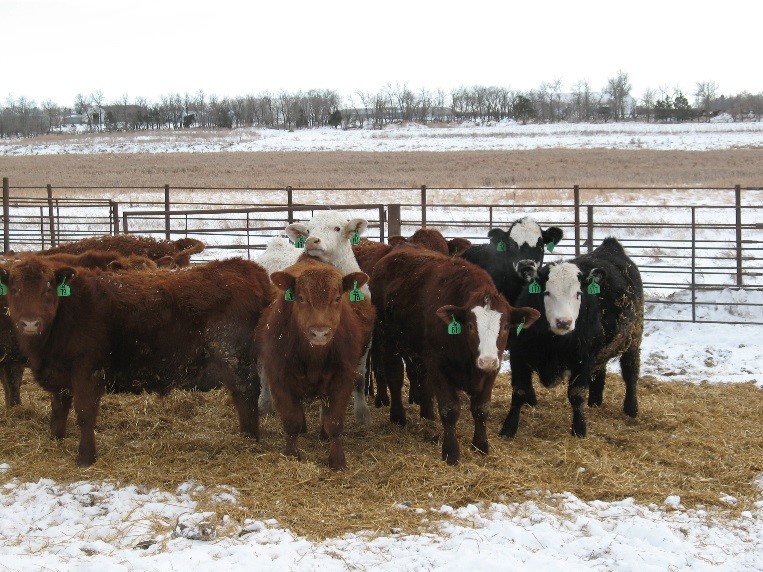
Dakota Feeder Calf Show Steers in the Feedlot.
The 2015 Dakota Feeder Calf Show cattle are currently in the feedlot at the CREC, participating in a research study looking at the effects of two fat levels (8% or 5%) in corn distiller’s dry grains when fed with corn or barley based feedlot growing and finishing diets. The cattle are currently on the finishing stage of the trial and are weighing 985 lbs and gaining 4.2 lbs/hd/d. The most recent Angus University cattle were placed on feed in June 2014 and marketed in October, weighing an average of 1390 lbs with an average daily gain of 4.40 lbs/hd/d. The NDAU cattle participated in a trial looking at the effects of feeding a traditional dry rolled corn diet compared to 3 corn tempering (corn is soaked or “re-wet” and then rolled) diets. Both of these trials, as with past trials will be analyzed and the data will be published in the North Dakota Beef report as well as the CREC research report and presented regionally at various producer programs. Producers that are interested in either of these feed-out programs are welcome to contact the CREC anytime.
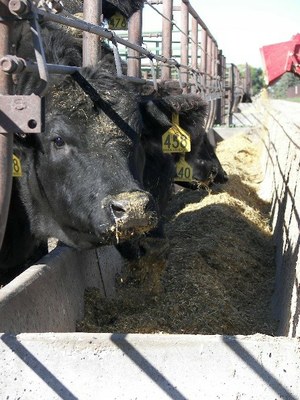
North Dakota Angus University Round-up: February 12, 2015 1-3pm
On February 12, 2015 from 1-3pm the Carrington Research Extension Center (CREC) and the North Dakota Angus Association (NDAA) will host the North Dakota Angus University Round-up at the CREC. The NDAU Round-Up is a classroom based program aimed at providing past and future NDAU consignors and others interested in the program an opportunity to gain information on how the program functions, specifics on how cattle in the program have performed, and insight into using carcass EPDs for making future bull selections. There will also be a time of discussion for attendees to ask questions and provide input. NDAU Round-Up presenters will include research, extension, and farm business management staff from the CREC. The session is free and open to the public.
Soybean Response to Tillage Systems
No-till soybean seed yield averaged 2.1 bu/acre (6%) greater compared to production in conventional-till when averaged across 12 years (2003-14) in the CREC's cropping systems study. Soybean grown in reduced tillage systems (no-till, strip till or direct seeded) averaged 4% more yield compared to conventional till across 37 site-years in NDSU trials conducted during 1999-2014.
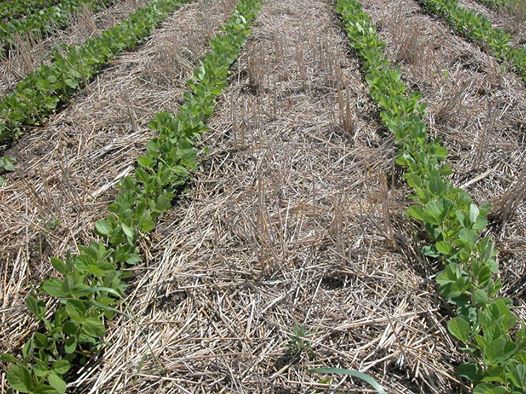
Soybeans planted using no tillage.
A soybean establishment study conducted at the CREC in 2011-12 included comparison of early planted soybean performance between two tillage systems. Soybean was planted May 5, 2011 and April 30, 2012 in conventional-till and direct seeded (into modest levels of small grain residue) plots, when soil moisture conditions were adequate for planting. Averaged across years, plant emergence was similar between tillage systems. Also, early season stands were similar: conventional-till = 132,000 plants/acre and direct seeded = 143,000 plants/acre. Seed yield averaged over the two years: conventional-till = 48.0 bu/acre and direct seeded = 49.2 bu/acre. The results from this study indicate that soybean plant establishment and seed yield were similar when planting early in a direct-seed environment compared to conventional till. Seed yield averaged over the two years: conventional-till=48.0 bu/A; direct-seeded=49.2 bu/A. The picture (taken June 2) was from the 2012 trial showing the two tillage systems.
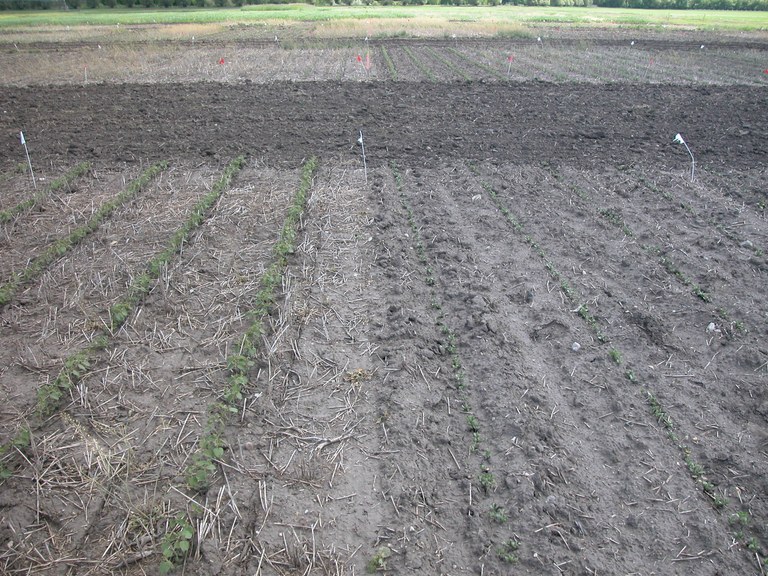
Comparison of early planted soybean performance between two tillage systems.
Greg Endres
Area Specialist, Cropping Systems
Mortality Composting
Internal temperature of a winter livestock mortality compost pile.
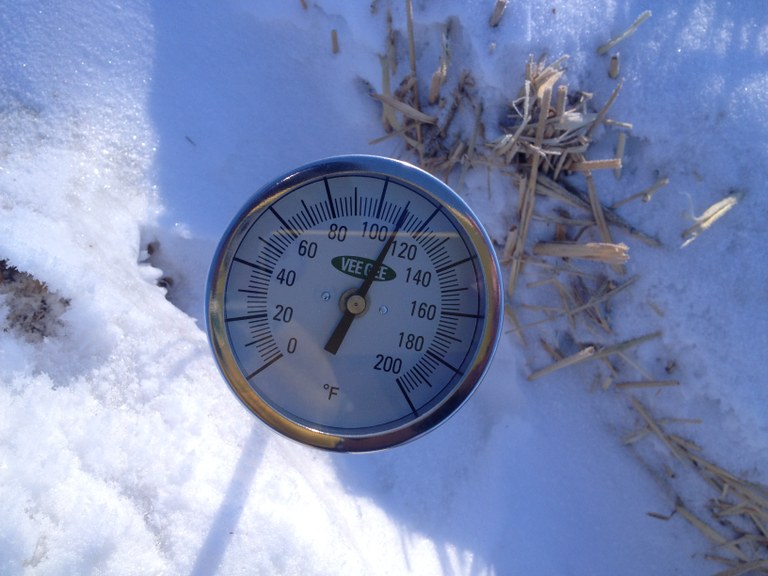
Livestock mortalities are an inevitable part of all livestock operations. Rendering, incineration, burial and composting are approved methods of carcass disposal in North Dakota. At the CREC, all livestock mortalities are composted.
Composting is a naturally occurring process that breaks the carcass into basic elements via microorganisms and heat generated during composting. Composting is a simple process that requires few materials and minimal maintenance.
Following are some tips on how to build a successful mortality compost pile or windrow:
- If composting one animal, build a pile.
- If composting several animals, build a windrow.
- You’ll need base material such as straw or old hay, bulking material such as manure or spoiled silage, and cover material such as straw, old hay or sawdust.
Use this process for composting:
- Start with 2 feet of base material in a windrow or circle, depending on how many carcasses will be composted.
- Lay the carcass on top of the base. Lance the rumen of mature cattle to ensure eruption does not occur. Have at least 1 foot of base material between the perimeter of the carcass and the edge of the base.
- Cover the carcass with 8 to 10 inches of bulking material.
- Cover the entire pile or windrow with 2 feet of cover material. The cover material should be placed on the top and sides, with no part of the carcass showing. The pile needs a good cap to keep predators out and seal in heat.
To maintain the compost site:
- Leave the pile or windrow undisturbed to keep heat sealed in during the very cold winter months.
- To accelerate the process, aerate the pile every two months using a loader from early spring until late fall.
- Make sure sufficient cover material always is present.
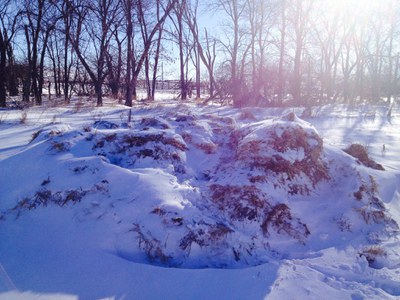
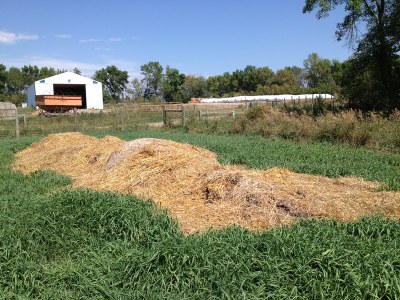
It is possible to compost livestock mortalities during both cold and hot seasons.
For more information:
- Check out these 2 links to the eXtension Livestock and Poultry Environmental Learning Center. They will provide more information as well as answers to frequently asked questions.
- View the LEM website with step-by-step instructions and photos: http://www.ag.ndsu.edu/lem/resources/animal-mortality-management.
- See NDSU’s “Animal Carcass Disposal Options” publication at http://tinyurl.com/carcassdisposal.
Interested in composting your livestock mortalites during calving this year? Contact me at Mary.Berg@ndsu.edu or 701/652.2951 for on-farm assistance!
Mary Berg
Livestock Environmental Management Specialist
A Note on Fruit Project Cooperators
I would like to acknowledge the ingenuity and craftsmanship of our local fruit businesses in North Dakota by highlighting one that has had recent success in a nationwide competition.
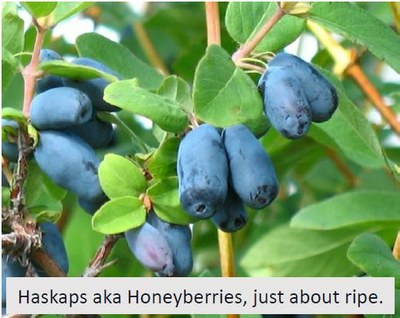
In November, Carrington area’s local winery, Dakota Sun Gardens Winery, Grace City, won a Jefferson Medal at the 15th annual Jefferson Cup Invitational with their Haskap wine. This is a pretty big deal! Only American wines that have already won other competitions are invited. This year, over 740 wines were invited to compete and in the end, just 38 won a Jefferson Medal. Bruce and Merleen Gussiaas' Haskap wine was one of just seven that won in the dessert category - and the only non-grape wine in the whole group of Jefferson Medal winners. The second wine they entered, Aronia wine, was also awarded a medal of excellence. This means they won two of the five top prizes given to the group of 12 fruit wine entries. http://thejeffersoncup.com/pages/2014%20Press%20Release.pdf
Dakota Sun Gardens is a great supporter of the efforts of the CREC Fruit Project and just one of several businesses that have used over 5,000 pounds of fruit from the project in the last five years. Others include: Berry Dakota, Jamestown; Maple River Winery, Casselton; Vintner’s Cellar, Bismarck; Karen’s Kuchens, Cavalier; and Tongue River Vineyard, Miles City, MT.
One of our initial goals was to introduce these hardy fruits to Pride of Dakota businesses that use fruit, in the hope that they would want to a) try the fruit, b) have customers like the product, and c) grow the fruit or find someone to grow it for them. It is not our intention to be the sole supplier of these fruits. The state needs growers and in the last two years there have been over a dozen requests for information from people who want to start orchards in the state. That’s exciting!
If you are a Pride of Dakota fruit-using-business and would like to try new fruit products, contact us and we’ll get you registered.
If you are interested in growing fruit for others, you need to talk to fruit-using businesses and find out their needs before you make planting decisions. Crops that are most desired now are haskaps/honeyberries, Juneberries, and black or red currants. The CREC has eight years of fruit production and growth information to help you make your decisions.
Kathy Wiederholt
Fruit Project Manager
Buying Bulls By the Numbers Workshop
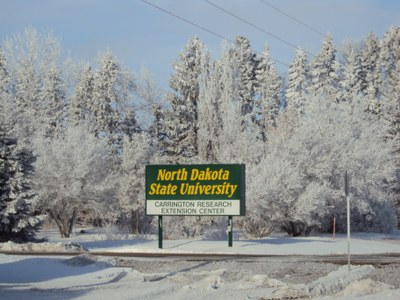 A workshop on using estimated progeny differences (EPDs) and DNA for beef cattle selection will be held at the CREC January 8th from 1-3pm CST. While visual appraisal and within-herd indexes can be used, using EPDs provides a better estimation of bull potential. EPDs are calculated using information from across many offspring (progeny), mostly due to the widespread use of artificial insemination.
A workshop on using estimated progeny differences (EPDs) and DNA for beef cattle selection will be held at the CREC January 8th from 1-3pm CST. While visual appraisal and within-herd indexes can be used, using EPDs provides a better estimation of bull potential. EPDs are calculated using information from across many offspring (progeny), mostly due to the widespread use of artificial insemination.
EPDS have expanded from just a couple traits like birth weight, weaning weight, and yearling weight to include calving ease, milk production, maternal, and carcass traits. Recently, index EPD traits are being provided for weaning, feedlot, and carcass. These multiple trait selection indexes allow for focusing on one index to allow greater selection pressure and faster genetic improvement.
This workshop helps to sort out the various EPDs that are important for a particular cow herd’s genetic future. The workshop also lets you compare your present bull EPDs to industry ranking and discuss your future breeding goals.
Leading the workshops will be Kris Ringwall, North Dakota State University Extension Service beef cattle specialist and Dickinson Research Extension Center director. Ringwall says. “The genetics of the beef herd in North Dakota is wide and varied. One example is birth weight. It is one of the major issues within the beef industry. Should the beef industry be able to regulate prebirth growth? Small or average calves at birth are possible, as is increased capacity to grow post-birth.”
“We want to give beef producers a close view of how EPDs can be a positive tool to improve herd performance and profitability,” Ringwall says. Workshop participants are asked to bring current sire registration numbers and sale catalogs from places where they purchased bulls.
Biological processes can and will respond to natural and man-made selection techniques. Using tools such as EPDs and DNA analysis, producers can select, purchase and use bulls that can provide profitability for their operation.
Workshop space is limited, so preregister by contacting Lee Tisor at lee.tisor@ndsu.edu or (701) 456-1105. For more information, contact Karl Hoppe Area Extension Livestock Specialist at karl.hoppe@ndsu.edu or (701) 652-2951.
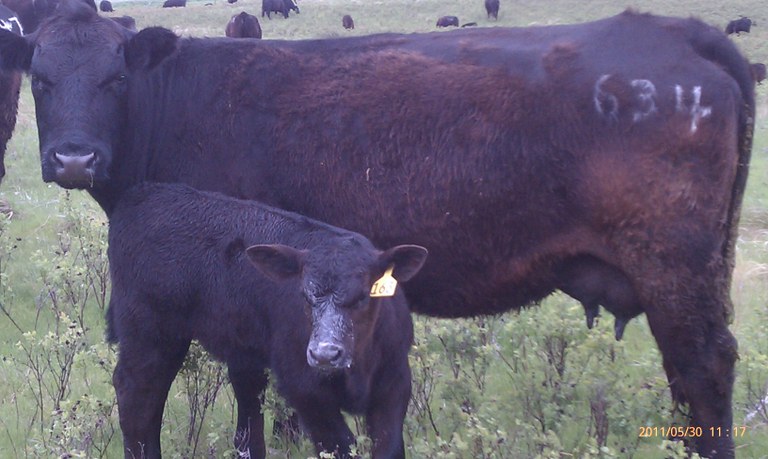
Karl Hoppe
Area Specialist, Livestock Systems


